#roman copy of greek sculpture
Explore tagged Tumblr posts
Photo
I'm doing an art project on this and...I've just realized I can't draw

Aphrodite Braschi, Roman copy of the Aphrodite of Knidos by Praxiteles , ca. 350–340 BC
Roman, 1st century BC
#help me#i'm ded#roman art#roman#1st century bc#marble statue#aphrodite braschi#aphrodite#aphrodite of knidos#praxiteles#350-340 bc#tagamemnon#roman copy of greek sculpture#roman sculpture#ancient rome
511 notes
·
View notes
Text

Copie de l’Artémis dite « Diane de Gabies », moulage de l'Atelier de Moulage de la Réunion des Musées Nationaux, Château d'Eu, Normandie, France
#Artemis#Diana#godess#greek paganism#greek mythology#roman paganism#roman mythology#roman polytheism#modern copy#classicism#classical antiquity#Antiquity#Roman Empire#Rome#ancient rome#sculpture#art#art history#France#Normandie#Eu#Europe
2 notes
·
View notes
Text
a store here is selling a reproduction of a greek/roman bust, and they're calling it a Venus bust, but i have this bust tattooed on my leg and i was very extremely sure that it was a bust of Diana 💀💀 my research tells me that it has to be a Diana bust bc the only sites telling me it's a Venus bust are online stores, and one official site has a reproduction of it that they call Diana (the original is in the Louvre supposedly but they havent uploaded it to their online collection).
#the struggle#it shows up when i google venus bust and diana/artemis bust#havent tried to google aphrodite bust but im pretty sure it's either roman or a roman copy of a greek sculpture so it'd have a roman name#(probably)#anyway im stressed a little
1 note
·
View note
Text




Statue of Marsyas, Roman copy of Greek original sculpture. First century BCE. Capitoline Museums
The monumental statue represents the silen Marsyas hanging on a tree, waiting to be flayed upon order by Apollo. The white-and-red Pavonazzo marble was likely used to emphasize the effect of the flaying.
66 notes
·
View notes
Text

Restored 'Apollo Belvedere' Marble Statue Back in the Vatican
The Vatican Museums on Tuesday unveiled the restoration of the celebrated second-century "Apollo Belvedere" sculpture following five years of work.
Once considered to epitomise classical Western ideals of beauty, the 2.24-metre-high (seven-feet-tall) marble statue shows the Greek god of medicine and poetry in motion, his left arm having just let fly an arrow from his bow.
Its around 260,000-euro ($280,000) restoration aimed to fix serious structural defects detected late in 2019, the restorers said.
Those notably included fragilities in the legs and an overall lack of balance in the structure, they told a press conference.
Thanks to the introduction of a carbon-fibre rod fixed to the back of the base, the "Apollo Belvedere" was successfully stabilised and presented to public applause at the Vatican's Pio-Clementine Museum.

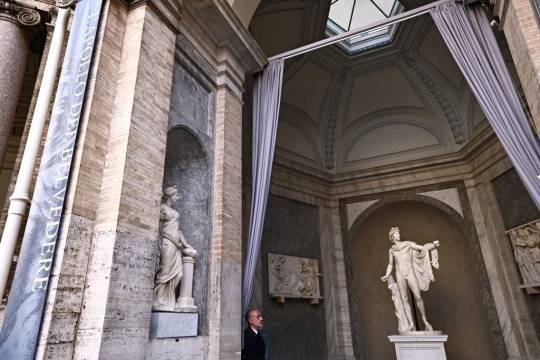
The most difficult thing was "not to touch anything on the sculpture" and avoid having to move and dismantle it, the restoration workshop's head Guy Devreux told AFP.
"We found this new system, which is a dynamic structural system based on the use of carbon fibre… and which, used in the right way, can give extraordinary results," he added.
For the Vatican Museums' director Barbara Jatta, "the main challenge was to have the courage to close access to such an important icon for our museums".
Discovered in 1489 among the ruins of an ancient Roman house, the "Apollo Belvedere" was brought to the Vatican by Pope Julius II.
Besides the carbon-fibre rod, the restorers also replaced the statue's left hand with a cast taken from a fragment of a plaster copy of the original Greek statue made in Roman times.
The "Apollo Belvedere" is in fact considered to be a marble copy of a bronze from around 330 BC attributed to Leochares, one of the foremost sculptors of his time.





#Restored 'Apollo Belvedere' Marble Statue Back in the Vatican#The Vatican#The Vatican Museums#Greek god of medicine#marble#marble statue#marble sculpture#ancient artifacts#archeology#archeolgst#history#history news#ancient history#ancient culture#ancient civilizations#roman history#roman empire#roman art#ancient art#art history
66 notes
·
View notes
Text




The Ludovisi Gaul (Galatian Suicide), 2nd Century BC
The Ludovisi Gaul is an ancient Roman statue depicting a Gallic man plunging a sword into his breast as he holds up the dying body of his wife. This sculpture is a marble copy of a now lost Greek bronze original.
📸 Palazzo Altemps, National Museum of Rome, Italy
#dark academia#light academia#classical#academia aesthetic#escapism#academia#books and libraries#classic literature#books#architecture#statue#sculpture#The Ludovisi Gaul#Galatian Suicide#2nd century#Gallic#roman#roman statue#greek#marble#Palazzo Altemps#National Museum of Rome#italy#royal core#cottage core#aesthetic#academic#artistic#tumblr
41 notes
·
View notes
Text


16/11/24
Marble statue of Hermes
Roman, Imperial period, 1st or 2nd century A.D. Copy or adaptation of a Greek statue of the late 5th or early 4th century B.C.
The statue is almost intact, although the surface was strongly cleaned as was the custom in the eighteenth century. During that period, newly excavated ancient sculpture was cleaned and restored in Roman workshops before being sold to members of the European nobility. This work was acquired by the English statesman William Fitzmaurice, second earl of Shelburne, who assembled a distinguished collection of antiquities at Lansdowne House in London. The statue of Hermes once stood in a niche in the dining room at Lansdowne House, serving the same decorative function that it doubtless once served in a Roman villa of the first or second century A.D. The dining room, designed by Robert Adam, is now at the Metropolitan Museum, where it is installed with other period rooms from England.
#photographers on tumblr#original photography#dark academia#dark academia aesthetic#classic academia#classic academia aesthetic#chaotic academia#chaotic academia aesthetic#art#greek mythology#cottagecore#cottagecore aesthetic#cottage aesthetic#dark cottagecore#nature photography#nature#naturecore#nature aesthetic#gardencore#earthcore#fairycore#fairy aesthetic#softcore#soft aesthetic#autumn#autumncore#autumn aesthetic
31 notes
·
View notes
Text
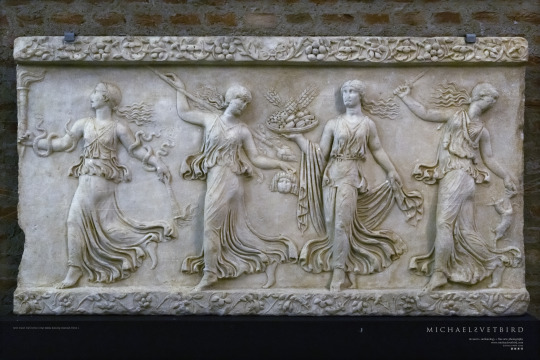
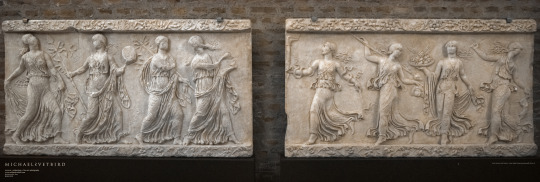
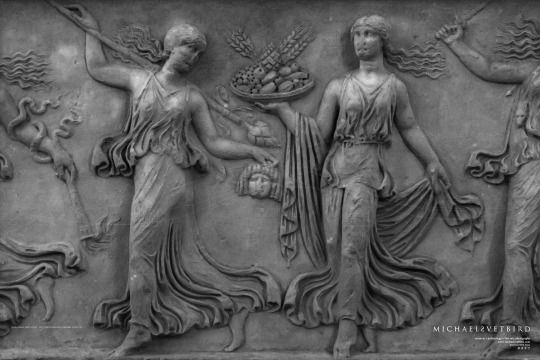
DANCING MAENADS: 2 Large Marble Frieze Reliefs H89 X W165 cm each, Roman "The female figures are faithful copies of the models created at the end of the 5th c. BC by the Greek sculptor Callimachus. Some, such as the maenad holding a basket full of fruit and the one screaming disheveledly brandishing two torches and with her arms wrapped in snakes, are however not typical of the Dionysian thiasos but refer to the iconography of an offering bearer or a Hora [season] and that of an Erinyes [personification of revenge especially towards those who attack one's family], themes that adapt to a funerary context." [txt ©MRT] White Marble Mid- 1st AD
LEFT [no faces preserved]
RIGHT [featured in this post].
Musei Reali Torino, Turin | MRT [Museum of Antiquities | Museo di Antichità, -1 Floor] • Web: https://museireali.beniculturali.it/en/archaeological-museum • FB: https://www.facebook.com/museirealitorino • IG: @ museirealitorino • X: @ MuseiRealiTo
MRT | Michael Svetbird phs©msp 18|02|24 6300X4200 600 [I.] The photographed objects are collection items of MRT, photos are copyrighted [non commercial use | sorry for the watermarks]
📸 Part of the "Reliefs-Friezes-Slabs-Sculpture" MSP Online Photo-gallery:
👉 D-ART: https://www.deviantart.com/svetbird1234/gallery/72510770/reliefs-friezes-slabs-sculpture
.
#turin#palazzo reale torino#musei reali torino#archaeological museum#museo archeologico#ancient sculpture#ancient art#roman#art history#antiquity#museology#archaeology#mythology#antiquities#heritage#ancient#sculpture#frieze#relief#maenads#maenad#dionysus#ancient greece#ancient rome#ancient world#sculpture photography#art photography#museum photography#archaeology photography#michaelsvetbird
119 notes
·
View notes
Note
I saw your post about Apollo's beauty and found another similarity with Dionysus, and i like it, because is another proof that these two are more similar than opposites...
*copy and paste the textes*
his fingers shaped as Bacchus might desire, his flowing hair as glorious as Apollo's, and his cheeks youthful and smooth (this was Ovid describing Narcissus's beauty, he is compared him to Apollo and Bacchus)
Now you’ve destroyed all that gorgeous hair. Hair that Apollo or Bacchus would have loved to call his own (Again both gods, used as an example of beauty hair)
Dionysus was in earliest times like the Mycenaean Era, despicted as growth bearded man, and he, as Apollo, adopted a more effeminate aspect in Hellenistic Period, as you said and cited in this:
"Coinciding with the development of the youthful male body in fourth century greek sculpture was the representation of androgyny: by the Hellenistic period, the deities Dionysus and Apollo, in particular, were reconfigured with a combination of masculine and feminine traits. The Romans, too, imagined these deities in androgynous terms, and, in Roman art, they are curly haired, sweet faced and round limbed."
- Gender and the Body in Greek and Roman Sculpture by Rosemary Barrow & Michael Silk
Also i found in Theoi an epithet shared with both gods:
INTONSUS, i.e. unshorn, a surname of Apollo and Bacchus, alluding to the eternal youth of these gods, as the Greek youths allowed their hair to grow until they attained the age of manhood,
Is curious how both gods become an ideal of youth male beauty (Dionysus more ambigous in sexuality for his epithet of "androgynous") But both were evoked as a "ideal of beauty in youth". Hermes was also an ideal of male youth, but i think that he was more associated with gymnastic and athletic sports, his beauty is not often described as the Apollo and Dionysus'one! (Not saying he wasn't beauty btw, Hermes my beloved you're beautiful ♡)
I realy like this, because is another proof of the similarities between these two gods and how modern conception of "opposites and rivals" is not so accurate... I mean, yes, they had differents aspects like "wild and civilisation", but the "order vs chaos" is not true, both deites had their chaotic and harmonious moments... And they shared the ideal of beauty and adopted effeminate aspects in Hellenistic and Roman period... And Renaissance's paints continued with this too!
I'm glad you noticed this little detail because I did too, when I was making that post! Isn't it neat how they are similar in their beauty as well?
37 notes
·
View notes
Text
The Ineffable Detective Agency presents: the origins of the white bust in the bookshop (a really lovely theory, you should read it!)
While trying to identify some of the art pieces used in Good Omens, we did some searching and came upon this gem:
Head of Benevento:
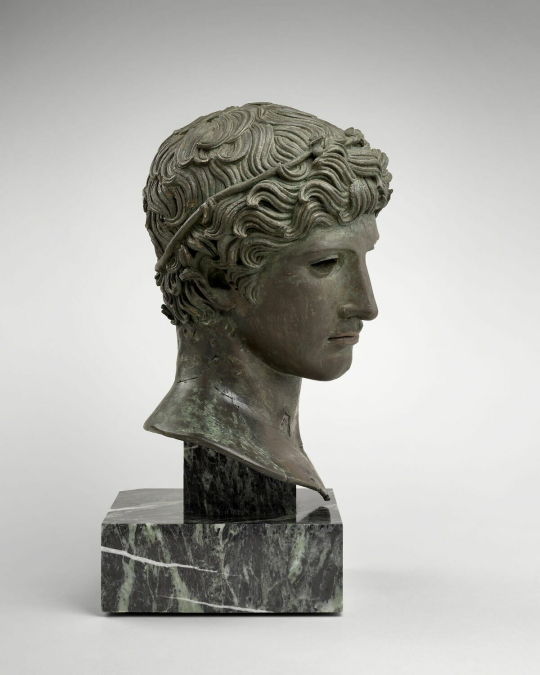
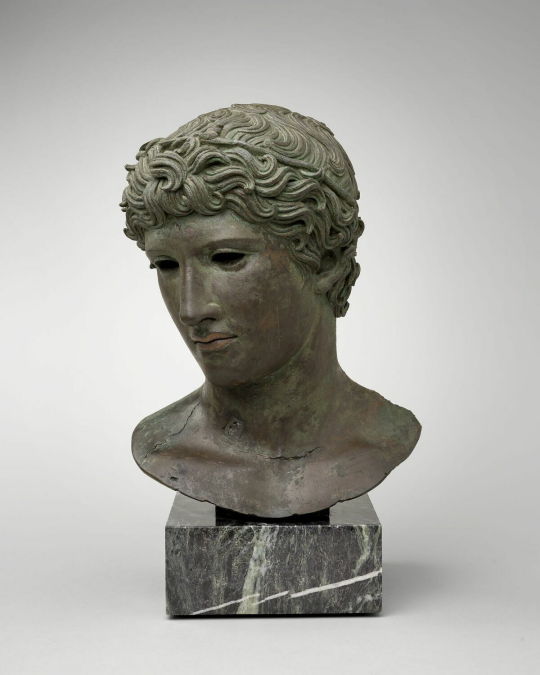
The statue in the bookshop looks like someone made a very close but inexact copy of the head of Benevento:
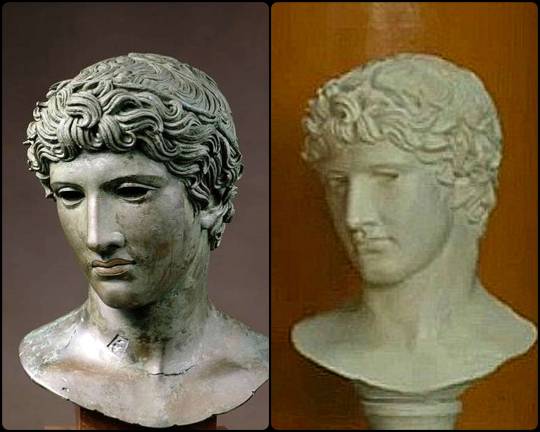
European art schools used copies of Greek and Roman sculpture to train their art students. So this COULD be one of those pieces. Or it could be a student copy; part of atelier training was to reproduce "master copies".
We know Aziraphale likes to learn human things from humans - he's taken lessons in dance, French, prestidigitation, and probably drawing. Did Aziraphale attend an atelier and receive formal artistic training that allowed him to do that drawing of Gabriel?
Could he have made the statue he now displays in his bookshop? Or was it gifted to him by a teacher, similar to the way he has a signed copy of the book from the magician who trained him, Prof. Hoffman himself?
But… who is it? We know people like to theorize the "floating white head" symbolizes the way the Metatron might be watching, but the actual statue doesn't look at all like him. So, is it just some random copy, or someone who has or will feature more in the story - just like that book from Prof. Hoffman had some significance?
Wait! Look closer!
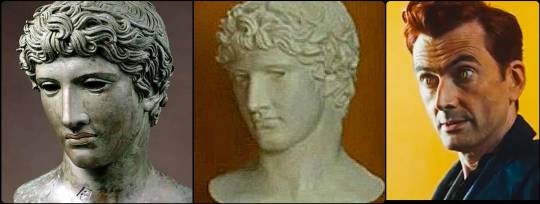
Our theory: around the same time that he was learning French, Aziraphale went to a Parisian atelier to formally study art. While there, he did the requisite student master copy of a Hellenistic bust that we know was known in France at the time, and disguised a portrait of Crowley in it. And then he proudly displayed it in his bookshop, in a very prominent/central position, to watch over everything.
Need a little more convincing? Look at these, which were filmed to give us the same angles:

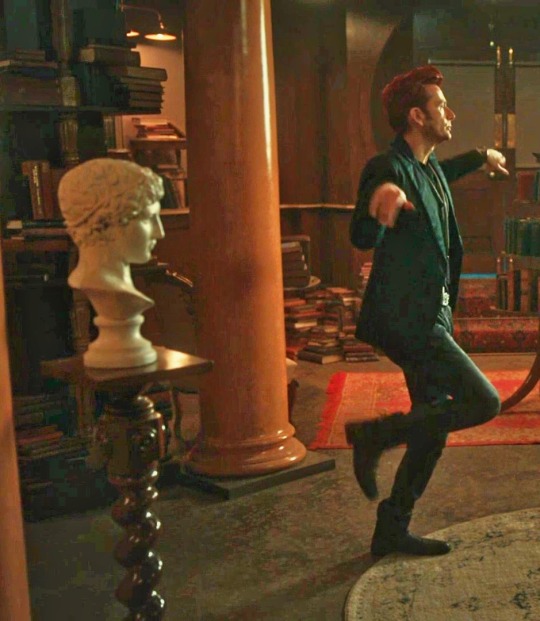
And here's the final proof - the first two images are overlays; the last one is the actual statue for comparison:

From a production standpoint, we know the huge Gabriel statue was an expensive custom order from Italy. Was this smaller Crowley statue also part of that order?
Let us know what you think!
Featuring contributions by @thebluestgreen, @postsforposting, and @embracing-the-ineffable at the Ineffable Detective Agency
See more of our posts plus a collection of Clues and metas from all over the fandom, here.
#Ineffable Detective Agency#ineffable mystery#good omens clues#good omens analysis#good omens meta#good omens season 2#crowley#aziraphale#ineffable partners#ineffable soulmates
166 notes
·
View notes
Text
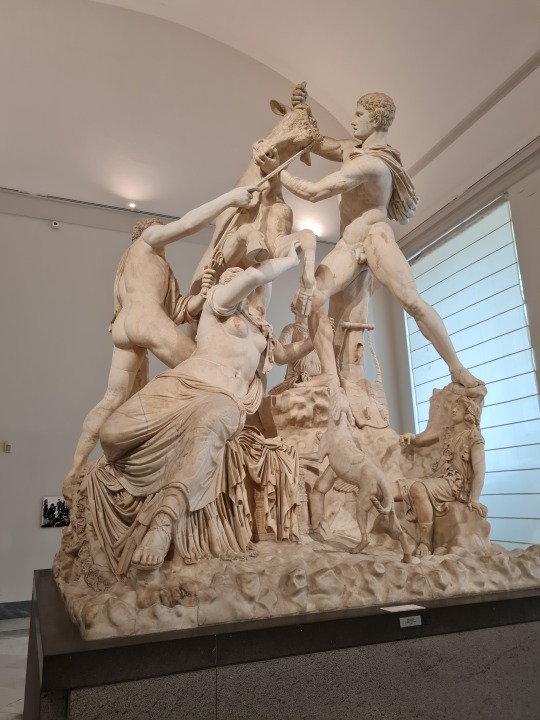



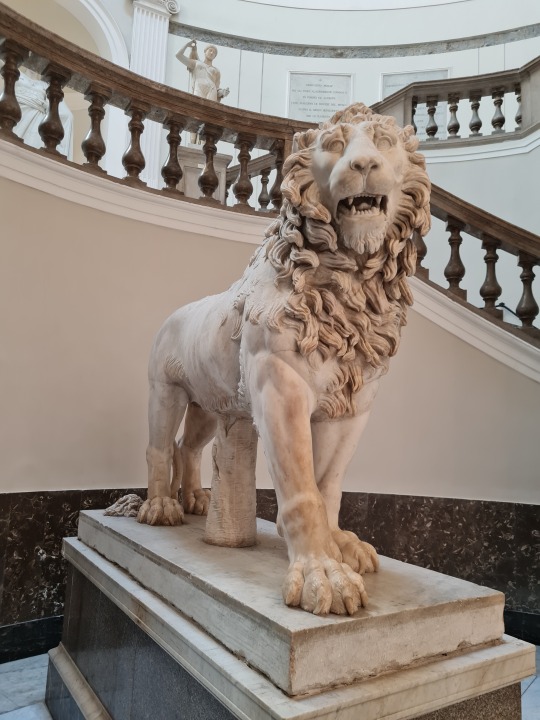
Sculptures in Museo Archeologico Nazionale di Napoli
1. The Farnese Bull, a Roman copy from 222-235 AD of a Hellenistic original from 160-150 BC.
2. Roman sculpture of Pomona (Flor Minor), 150-200 AD.
3. The Flora Farnese, originally a Roman sculpture of Aphrodite that was interpreted as Flora in the 19th century.
4. The Farnese Hercules, a third century AD copy by Glykon of a Greek original by Lysippos (4th century BC).
5. Roman sculpture of a lion, 2nd century BC.
#roman art#sculpture#napoli#italia#italy#italytravel#history#culture#travel#travel photography#art#art history#ancient history#ancient rome#archeology#antiquity#ancient sculpture#photographers on tumblr#photography#museum photography#museum#art photography#greek mythology#roman mythology#mythology and folklore#farnese#flora#hercules#statues#roman gods
55 notes
·
View notes
Text

The statue is a Roman copy of the Greek "Aphrodite of Knidos," originally sculpted by Praxiteles in the 4th century BCE. This groundbreaking piece caused an uproar in the Hellenic world as it was the first full-scale nude depiction of a woman. While earlier depictions of women may have been revealing, this statue marked a transformative moment in the artistic portrayal of the female form.
After the initial shock subsided, the practice of depicting Greek women and goddesses in the nude became more accepted. The "Aphrodite of Knidos" is one of the most replicated sculptures in antiquity. Its iconic pose—Aphrodite modestly covering her private parts while holding a towel, emphasizing her nudity—has become universal visual language. The composition invites the viewer to feel as though they are secretly witnessing the goddess preparing for a ritual bath.
Praxiteles' original masterpiece was intended for the Temple of Aphrodite in Knidos.
#ancient greece#ancient history#hellenism#art history#sculpture#greek sculpture#aphrodite#greek art#ancient religion
20 notes
·
View notes
Photo

Laocoön: The Suffering of a Trojan Priest & Its Afterlife
The sculpture group of Laocoön and His Sons, on display in the Vatican since its rediscovery in 1506, depicts the suffering of the Trojan prince and priest Laocoön (brother of Anchises) and his young sons Antiphantes and Thymbraeus and is one of the most famous and fascinating statues of antiquity. In his Natural History, Pliny the Elder states that the Laocoön, created by the eminent Rhodian sculptors Hagesander, Polydorus, and Athenodorus, “is a work of art to be preferred to any other painting or statuary” (36.37). Among art historians, the sculptural group has received near-universal acclaim ever since its rediscovery under questionable circumstances in 1506.
Is the statue famously shown since its discovery in the newly designed Belvedere Garden at the Vatican Palace actually the ancient sculpture mentioned by Pliny, or rather a clever Renaissance forgery? If the latter, who may have contrived this masterful deception? If the former, is it an original, or a marble copy of a Hellenistic bronze made for a Roman patron?
Beware of Greeks Bearing Gifts
In the most famous version of the story, as told by Virgil (70-19 BCE) in his Aeneid, Laocoön had warned his fellow citizens against the Greeks “even if they bear gifts,” and had tried to expose the true nature of the wooden horse by striking it with a spear (the wooden horse in question, of course, being the notorious “Trojan Horse”, left by the Greek forces on the coast so as to provide access into the city to the troops hidden inside the construction). When later two serpents emerged from the sea to kill the priest and his sons, the Trojans interpreted their horrific deaths as an act of divine retribution and promptly decided to move the wooden horse into the city, believing the contraption to be an offering to Minerva (Athena).
According to Arctinus of Miletus, the earliest tradition of the tragedy (surviving only through later citations), Apollo had sent the two serpents to kill Laocoön and only one of his sons; while the later author Quintus of Smyrna maintains that the serpents killed both sons but spared the father.
Servius, another late authority (c. 400 CE), tells us how Laocoön managed to incur the wrath of Apollo by sleeping with his wife before the cult statue in the god's temple. An even later source, the Byzantine scholar Tzetzes, adds that the scene of Laocoön's death took place in the very temple of the Thymbraean Apollo – appropriately setting the punishment at the scene of the crime.
The 5th-century BCE Greek playwright Sophocles produced a tragedy on the subject, of which only a few fragments survive in later citations. Apart from the sources mentioned above, Hellenistic poets Apollodorus and Euphorion, the historian Dionysius of Halicarnassus, the Roman novelist Petronius, the Latin fables attributed to Hyginus, and a few other fragments, all provide various details of the tragic story.
Despite this appearance in ancient literature from the post-Homeric to Byzantine traditions, artistic representations of Laocoön's suffering are few and far between. Depictions appear in some Greek vase paintings (5th to 4th centuries BCE) and in two frescoes at Pompeii (c. 25-75 CE). The marble statue group of Laocoön and His Sons, therefore remains the most exceptional portrayal of only a handful of ancient works illustrating the suffering of Laocoön.
Continue reading...
65 notes
·
View notes
Text

Unknown Artist
Statue of Thetis with a triton, Roman copy from a Greek original of the 2nd century BC, Thasian marble. A recent reconstruction identifies the statue as a part of the sculptural group by Skopas of Thetis giving her son Achilles new weapons described by Pliny. According to this theory, the statue known as “Ludovisi Ares” would actually represent Achilles. (x)
Palazzo Massimo alle Terme, Rome
16 notes
·
View notes
Text

Marble statue of an old woman. x
Roman copy of a Greek work of the 2nd century B.C.
These young girls, linked i
During the Hellenistic period, artists became concerned with the accurate representation of childhood, old age, and even physical deformity. The range of subject matter was extended to include genre-like figures from the fringes of society. Fine, large-scale statues of fishermen, peasants, and aged courtesans became valued religious dedications, sometimes placed in a park-like setting within the sanctuary of the god. Although this statue is known familiarly as The Old Market Woman, it probably represents an aged courtesan on her way to a festival of Dionysos, the god of wine. Her delicate sandals and the ample material in her thin, elaborately draped chiton are a far cry from the rough garb of a peasant woman. The ivy wreath on her head marks her association with Dionysos, and the basket of fruit and the two chickens must be dedicatory gifts to the god or simply her own provisions for a long day of celebration. Veneration of Dionysos was widespread during the Hellenistic period, and ancient literary descriptions give an idea of the extraordinary processions and festivals held in his honor. The flattened composition of the figure is typical of sculpture created in the late second century B.C. The original work may have been dedicated in a sanctuary of Dionysos. The Roman copy could have decorated a garden.
28 notes
·
View notes
Text
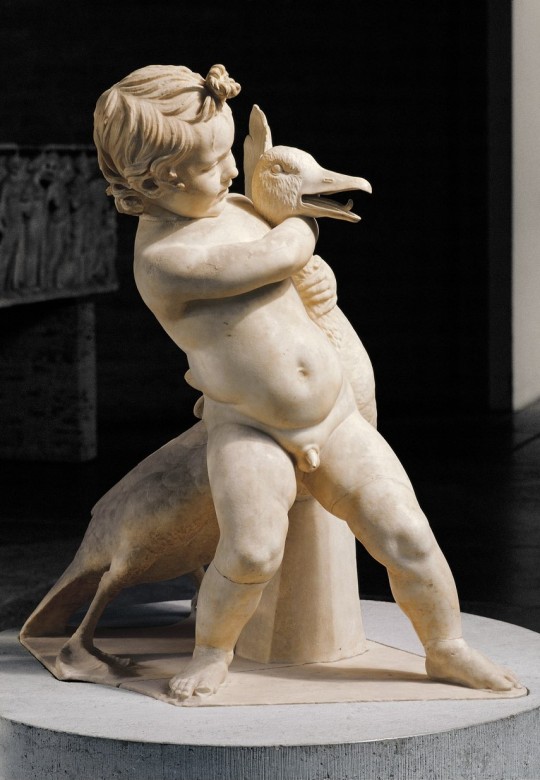
Boy with a goose, Roman copy of a Greek sculpture ca. 220 BC, marble, München Glyptothek.
159 notes
·
View notes